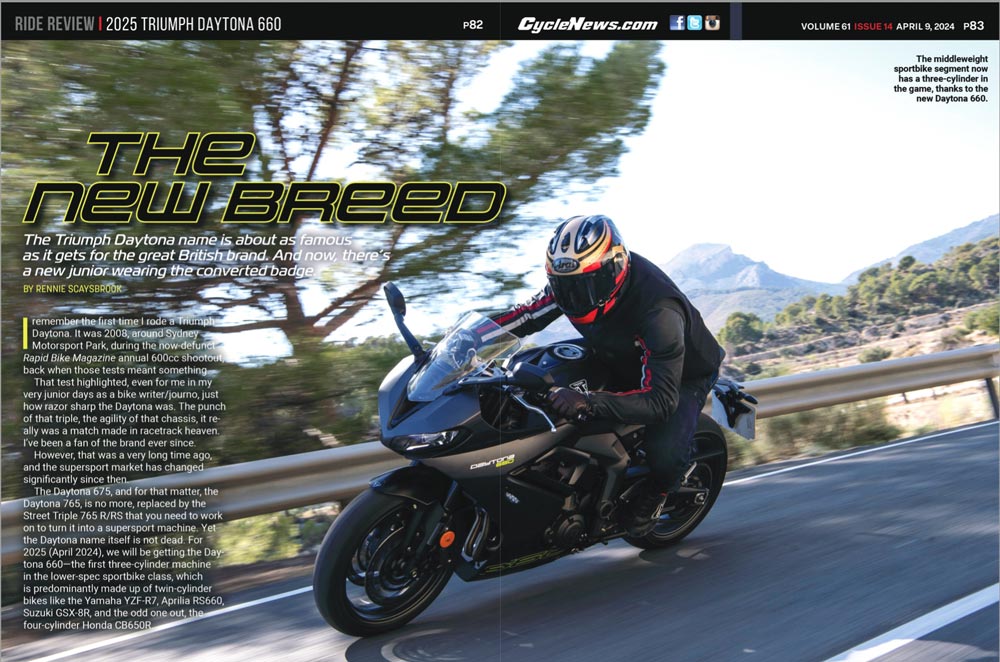Rennie Scaysbrook | April 11, 2024
I remember the first time I rode a Triumph Daytona. It was 2008, around Sydney Motorsport Park, during the now-defunct Rapid Bike Magazine annual 600cc shootout, back when those tests meant something.
That test highlighted, even for me in my very junior days as a bike writer/journo, just how razor sharp the Daytona was. The punch of that triple, the agility of that chassis, it really was a match made in racetrack heaven. I’ve been a fan of the brand ever since.
However, that was a very long time ago, and the supersport market has changed significantly since then.
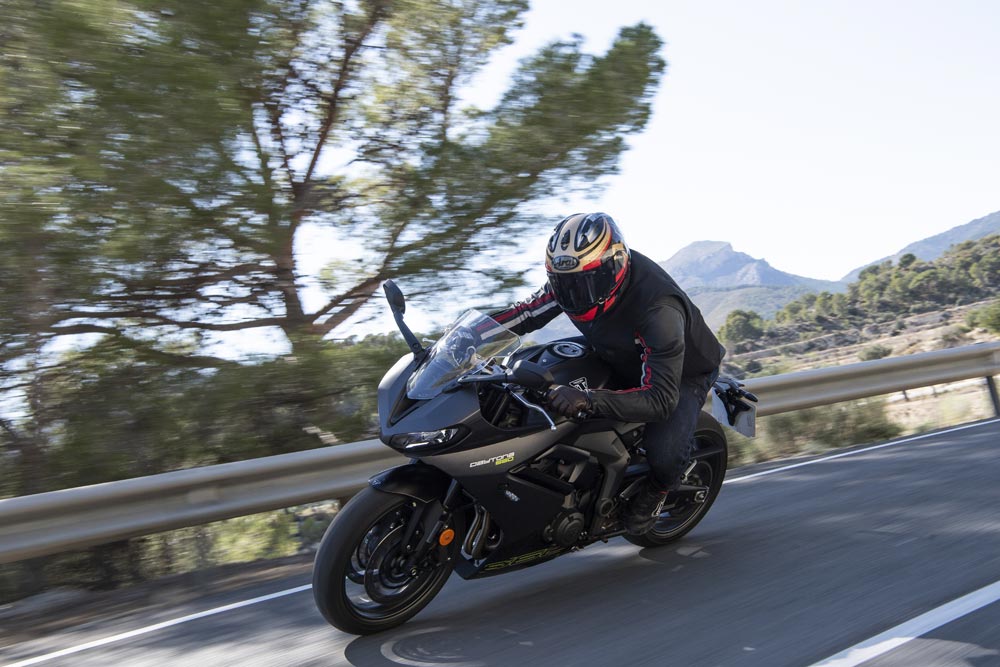 The middleweight sportbike segment now has a three-cylinder in the game, thanks to the new Daytona 660.
The middleweight sportbike segment now has a three-cylinder in the game, thanks to the new Daytona 660.
The Daytona 675, and for that matter, the Daytona 765, is no more, replaced by the Street Triple 765 R/RS that you need to work on to turn it into a supersport machine. Yet the Daytona name itself is not dead. For 2025 (April 2024), we will be getting the Daytona 660—the first three-cylinder machine in the lower-spec sportbike class, which is predominantly made up of twin-cylinder bikes like the Yamaha YZF-R7, Aprilia RS660, Suzuki GSX-8R, and the odd one out, the four-cylinder Honda CB650R.
The Daytona 660 represents a major shift in the sportbike segment for Triumph. As Triumph’s Chief Product Officer Steve Sargent says, “Supersport bikes of the last 15 years have essentially priced themselves out of relevance. The cost of these bikes was getting closer and closer to those of liter bikes, but without the performance to back them up. We’ve taken a different approach with the new 660 in that we’re focusing on everyday street performance but one that’s financially accessible to most people.”
Those reading between the lines will note a couple of cryptic messages. The first is that if you’re expecting a “traditional” Daytona with all the supersport aplomb, forget it. The second is the “financially accessible” part, whereby certain concessions need to be incorporated into the design to make it so. But we’ll get to that in a minute.
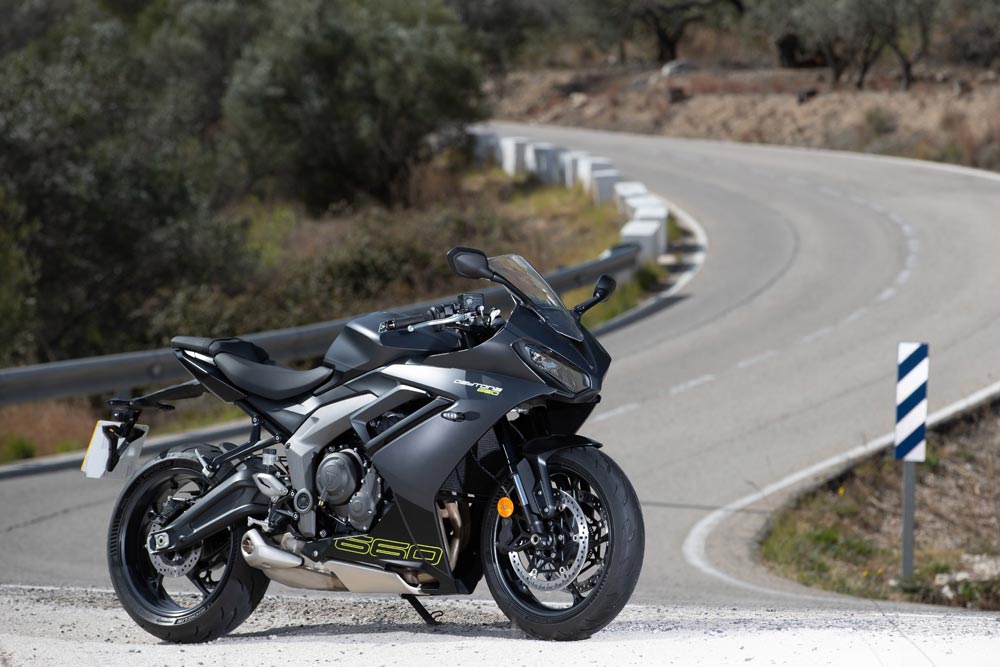 Are the days of clip-on sportbikes all but over? Judging by the slew of new models with handlebars mounted above the triple-clamps, very possibly.
Are the days of clip-on sportbikes all but over? Judging by the slew of new models with handlebars mounted above the triple-clamps, very possibly.
The new Daytona 660 takes much of its inspiration from the Trident 660, Triumph’s mid-size naked bike that goes up against machines like the Yamaha MT-07 and, again, the Honda CB650R. The Daytona, however, is a fair bit enhanced in comparison to the Trident, producing a claimed 17 percent more power and nine percent more torque than the naked bike brother. Triumph is claiming a very healthy 93 horsepower at 12,250 rpm and 51 lb-ft of torque at 9250 rpm, with 80 percent of that torque available at 3125 rpm.
Achieving those numbers comes via a revised motor with a new forward-mounted intake, three new 44mm throttle bodies compared to the Trident’s single 38mm unit, a new cylinder head, longer lift and higher duration exhaust camshaft, revised pistons, crankshaft and bearings. The six-speed gearbox has also come in for revision, with a longer first and second and shorter third, fourth, fifth and sixth gear to help the Daytona get to the top speed faster.
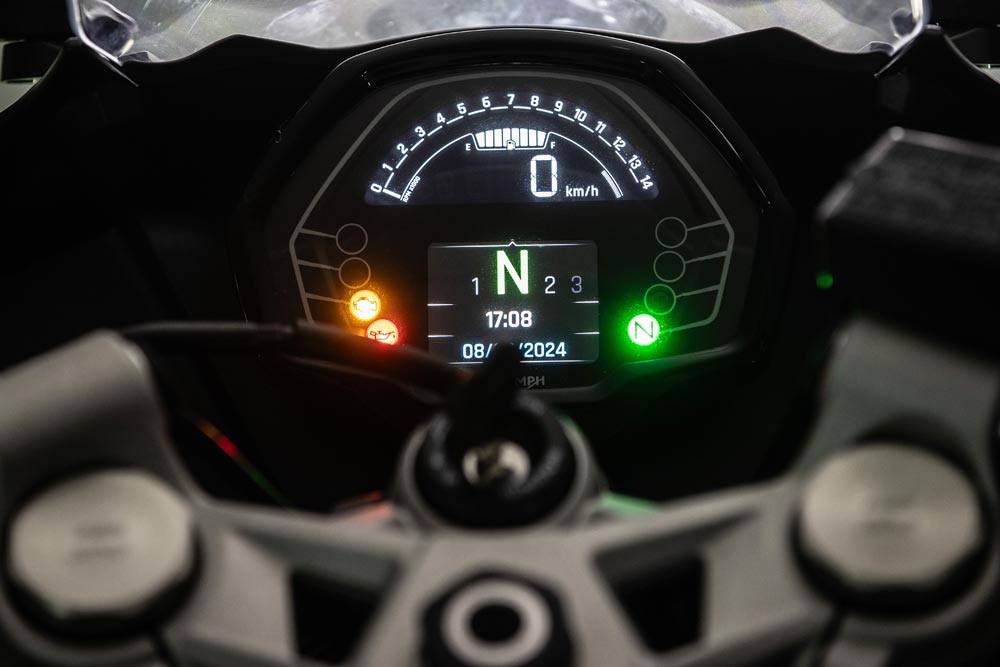 Dash is basic at best but provides all the info you need and nothing you don’t.
Dash is basic at best but provides all the info you need and nothing you don’t.
All that tech makes for a thoroughly fun little motorbike in the twisties. I don’t know if 93 horsepower is exactly what you get; my guess is it’s somewhere around the early 80s at the wheel, but the three-cylinder motor produces such fantastic performance that you quickly forget about the number and just focus on enjoying the ride.
There are three throttle modes: Sport, Road, and Rain. While I did play with Rain just to see the difference in power delivery (hint: it neuters the bike pretty well), you will spend most of your time in Sport and Road.
Road will be fine for most situations, but Sport is the place to hang out. Throttle response in Sport is a touch jerky, but you get all the motor has to offer, and given it’s only got north of 80 horsepower, Sport is fine for most situations.
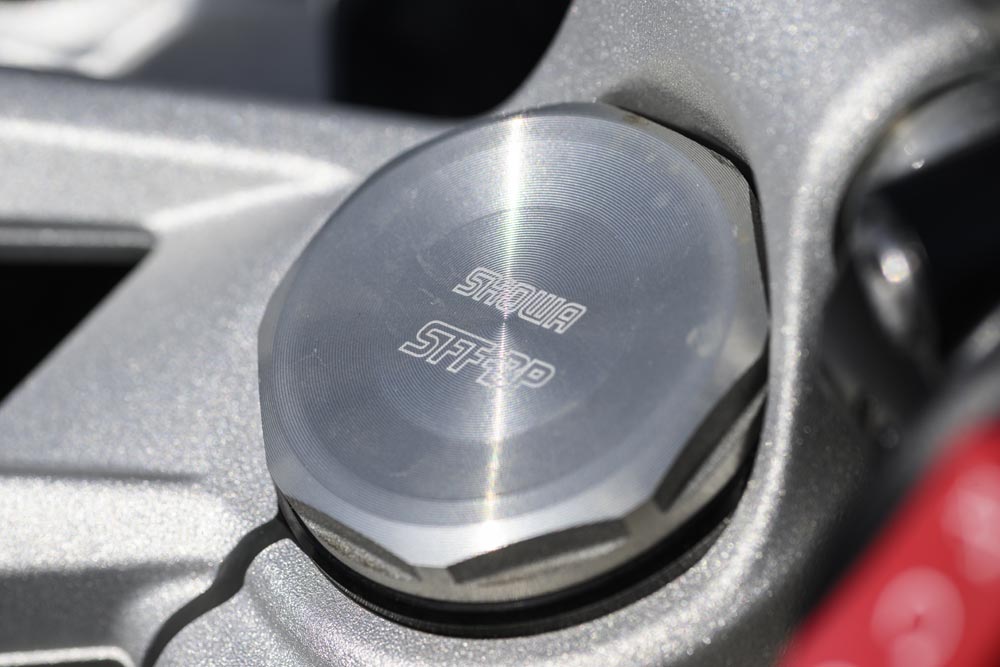 Showa’s Separate Function Fork-Big Piston front-end adorns the 660. It’s fine up to a certain speed, then loses its way.
Showa’s Separate Function Fork-Big Piston front-end adorns the 660. It’s fine up to a certain speed, then loses its way.
Top-end power is surprising, however. The little triple loves a good rev, ripping up through the rev range and providing plenty of performance in response. The harder you push the motor, the better it feels, which, sadly, is not the same for the suspension. More on that in a tick.
The gearbox is devoid of a quickshifter in standard trim, but it’s almost not needed as the standard Triumph gearbox is bloody good—just a slight roll of the throttle and snick the next gear—beautiful.
The engine and gearbox provide a lovely duet to your ride, but what of the chassis? Well, it’s a case of could be better.
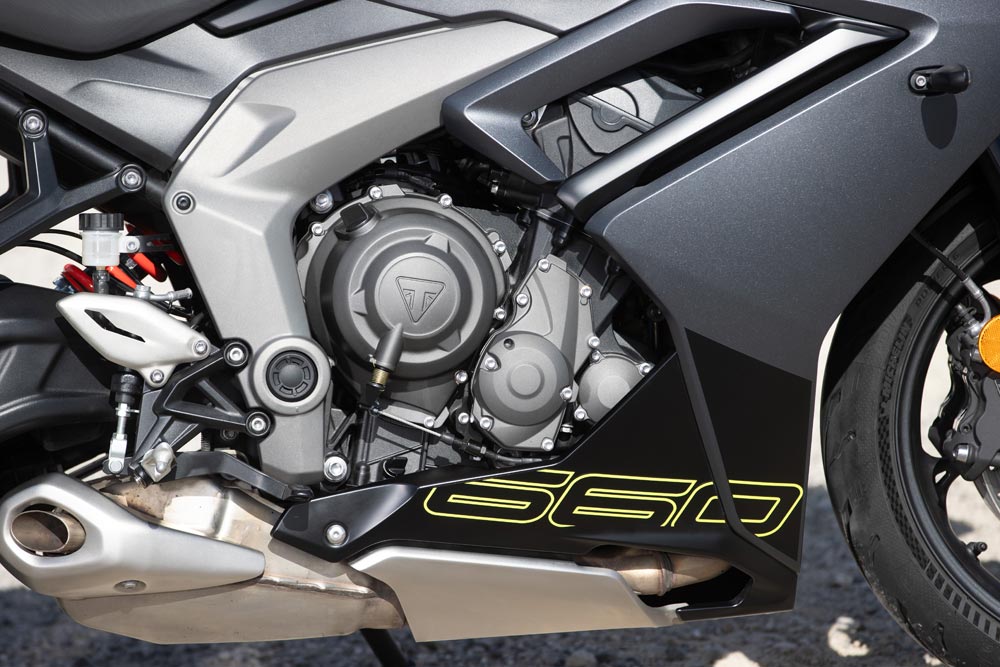 A touch over a claimed 90 horsepower hides in that three-cylinder motor. It’s a lovely little engine.
A touch over a claimed 90 horsepower hides in that three-cylinder motor. It’s a lovely little engine.
You (and I) both need to remember the one keyword in the chassis: price. Given the 660 tips the financial scales at $9195, you can’t expect race-bred springers here. The suspension consists of unadjustable 41mm Showa Big Piston Fork units offering 4.3 inches of wheel travel, while the rear runs a Showa RSU with preload adjustment and 5.1 inches of wheel travel. At regular road speeds, the Daytona’s suspension will be up to most tasks you can throw at it. Cruising through to the twisties in Spain’s Alicante in Spain showed a bike that’s perfectly capable of deflecting the crappy road surfaces and potholes without upsetting the chassis too much, and at this speed, the ride is entirely pleasant.
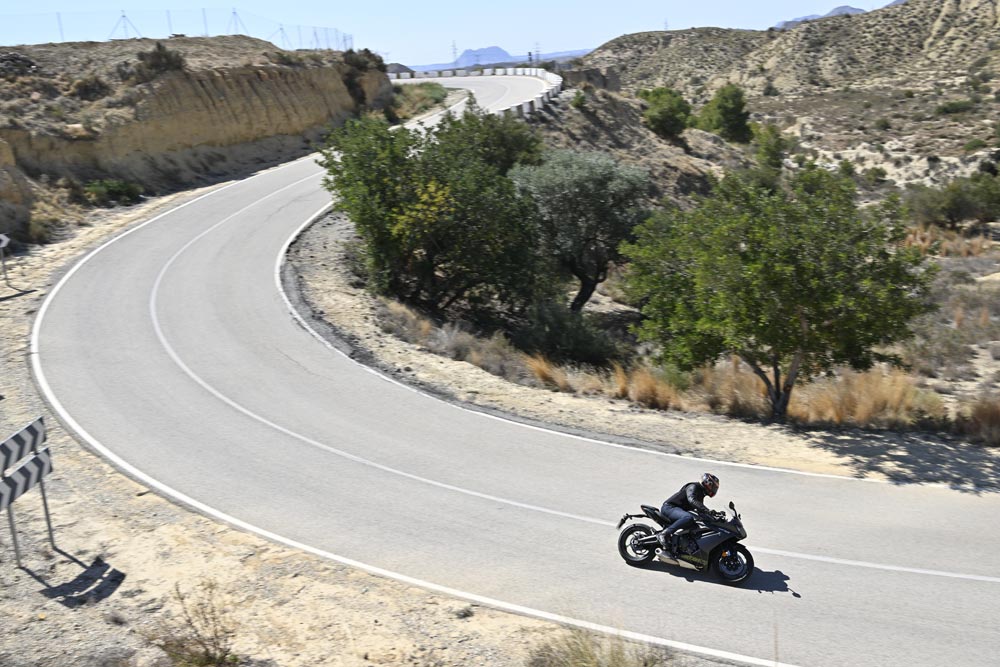 Alicante hills and a new Triumph. Doesn’t get much better than this.
Alicante hills and a new Triumph. Doesn’t get much better than this.
Triumph is betting (and they’re probably right) that the Daytona will mostly be ridden in this type of setting by riders early in their riding careers who are thus not as demanding in terms of suspension tech.
Up the pace a little and the Daytona still holds its own, offering agile steering and braking performance, but up it to where you’re trying to have a bit of canyon fun and you’ll reach the limits of the suspension really quickly.
During the last half of the day after a photoshoot, we really started to screw it on, and the fork quickly reached its limit, diving to the bottom of the stroke and rebounding far too quickly, thus taking the weight off the tire and making the front-end a little slippery. Therefore, the faster you went and the harder you rode the Daytona, the more it would protest (at least in terms of chassis. The engine, as mentioned, loves a good thrashing).
I keep having to remind myself of the cost factor involved, so I can’t be too harsh on the Daytona’s rude quality. For the most part it’s fine, soft but fine, and if you’re under the 195 pounds of my frame, you’ll probably not have too many issues.
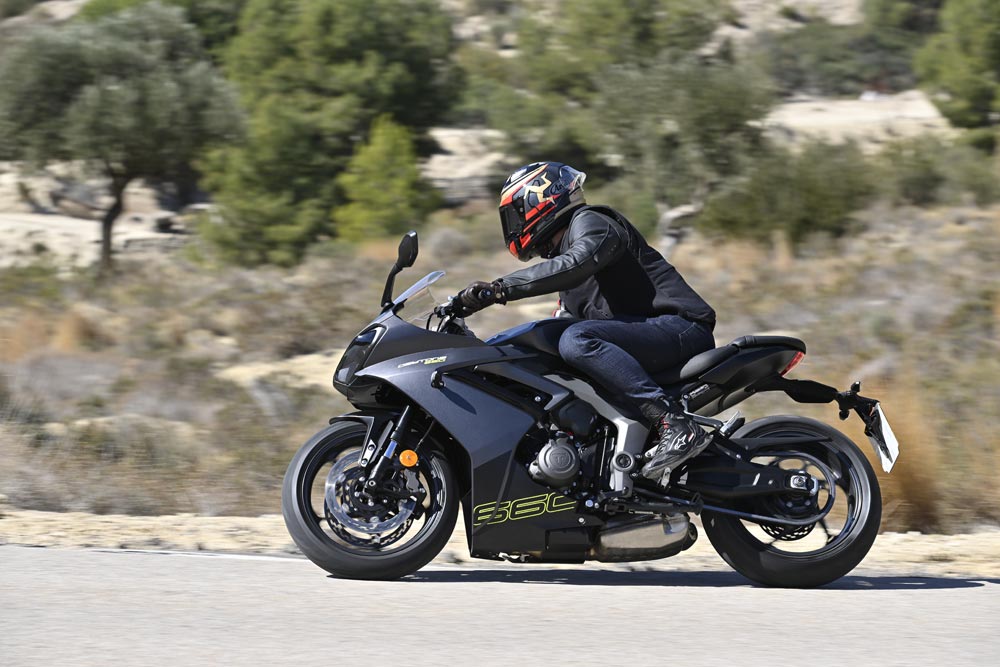 Ride position is just on the sporty side of upright.
Ride position is just on the sporty side of upright.
If I were to buy a Daytona 660, the very first thing I would do is head over to Peter Hickman Racing and invest in one of the Bitubo suspension kits he’s developed for the 660. PHR is Triumph’s race development team of choice and thus has a huge range of aftermarket pieces you can pick up like race bodywork, a new subframe, race seat, rearsets, clip-ons, race ECU and the wiring loom to go with it, but you can keep most of that as far as I’m concerned, just give me a more compliant (and adjustable) suspension package, please, Mr. Hickman.
The Daytona sits almost between the Suzuki GSX-8R and the Yamaha YZF-R7 in terms of ride position. The pilot is a little forward from center but not so much as to put weight on the wrists.
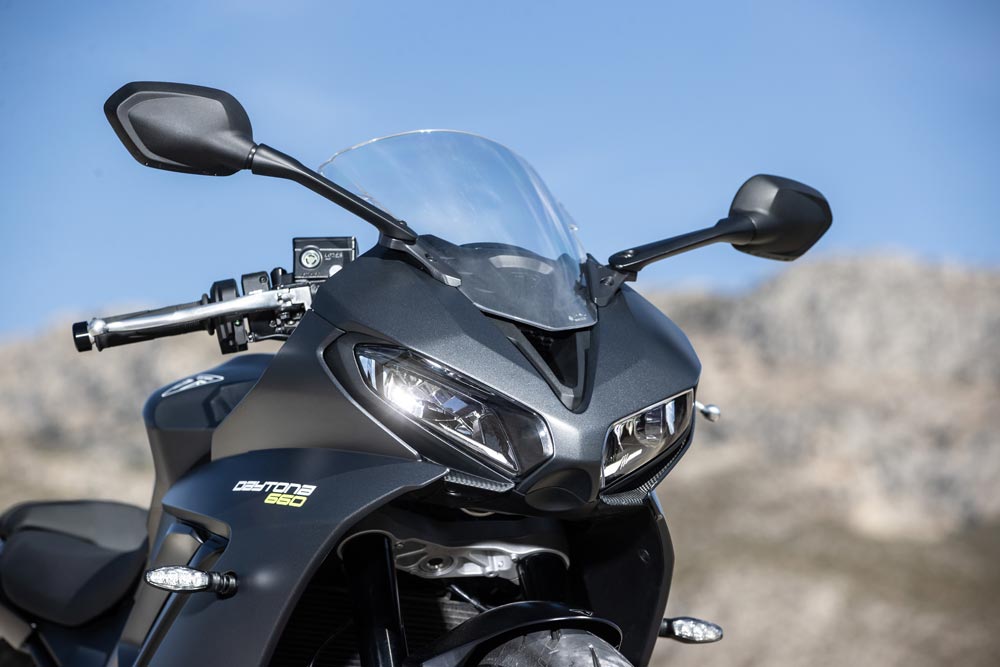 It’s no supersport bike in the traditional sense, but the 660’s face is still unmistakably Triumph.
It’s no supersport bike in the traditional sense, but the 660’s face is still unmistakably Triumph.
The ride position is a comfortable one for long days in the saddle with the handlebars mounted above the triple-clamps, and the Daytona has a nice little flair to its looks that’s lacking on bikes like the Ninja 650 and CB650R.
The Daytona 660 is a good base bike, but it needs work to make the chassis handle as good as the engine goes. Whereas the Yamaha YZF-R7 is a pure sportbike ready to rock, the Daytona is part of the new breed of part sportbike, part street bike, part commuter, part whatever you like. Ironically, that’s what the supersport market was intended to be when it was born back in the 1980s—bikes that could be a jack of all trades. Mark my words. You’ll see more bikes like this in the coming years, probably in higher-capacity units as well. For now, the Triumph Daytona 660 is a good bike, but I’d love to ride a sorted one.CN
VIDEO | 2025 Triumph Daytona 660 First Ride
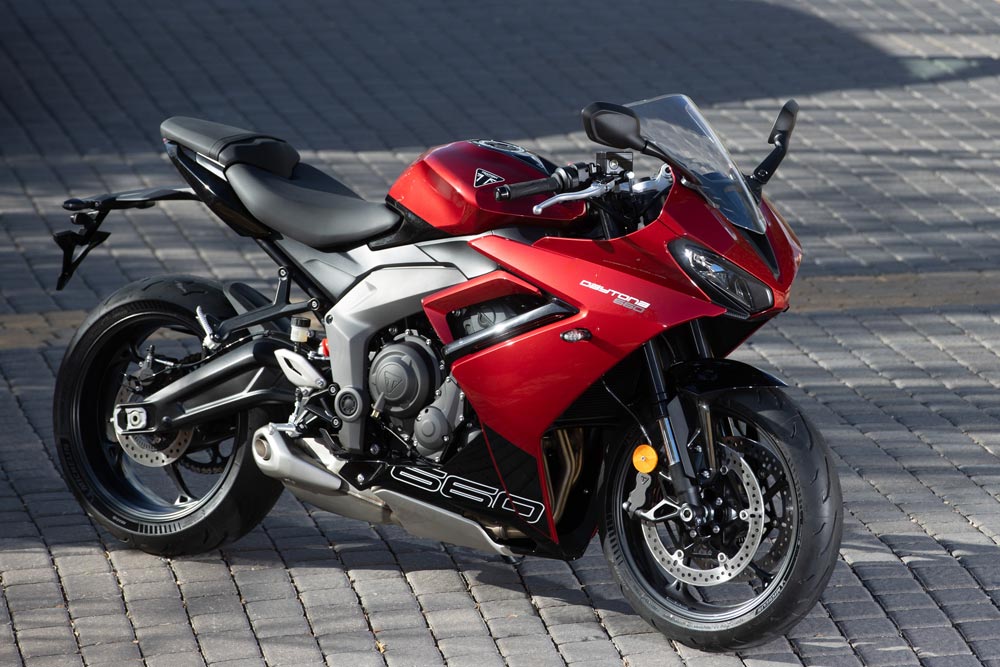
2025 Triumph Daytona 660 Specifications
| MSRP: |
$9195 |
| Engine: |
4-stroke, inline 3-cylinder, 240° firing order |
| Valvetrain: |
12-valve, DOHC |
| Displacement: |
660cc |
| Bore x stroke: |
4 x 51.1mm |
| Compression ratio: |
12.05:1 |
| Cooling system: |
Liquid |
| Max power: |
95hp at 11,250 rpm |
| Max Torque: |
50 lb-ft at 8250 rpm |
| Fuel system: |
Electronic fuel injection system, three 44mm throttle bodies with ride-by-wire system |
| Exhaust: |
3/2/2001 |
| Transmission: |
6-speed |
| Electronics: |
Three Riding Modes, optional Quick Shift up/down, full LED lighting system, traction control, ABS |
| Chassis: |
Tubular steel perimeter frame |
| Front suspension: |
44mm Showa SFF-BP fork, non-adjustable; 4.33 inches of travel |
| Rear suspension: |
Showa monoshock, preload adjustable; 5.1 inches of travel |
| Front brake: |
Dual 4-piston monobloc calipers, 310mm discs, ABS |
| Rear brake: |
2-piston caliper, 220mm disc, ABS |
| Front tire: |
120/70 ZR17 in. |
| Rear tire: |
180/55 ZR17 in. |
| Rake: |
23.8° |
| Trail: |
3.24 in. |
| Wheelbase: |
56.1 in |
| Seat height: |
32.7 in. |
| Fuel capacity: |
3.7 gal. |
| Weight (curb, claimed): |
443 lbs. |
